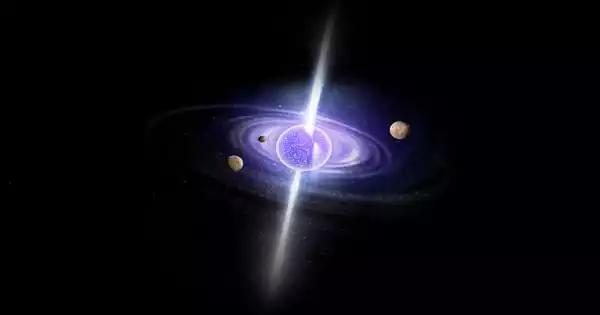PSR B1257+12 is a millisecond pulsar located 2,300 light-years from the Sun in the constellation Virgo, rotating at approximately 161 times per second (faster than the blade of a blender). It is approximately 1,000 light-years away from Earth and is a millisecond pulsar with a period of 6.2 milliseconds. It is also known as Lich, after the fictional undead creature of the same name. The planets have masses ranging from 0.02 to 4.3 times that of Earth and orbit the pulsar at distances ranging from 28 to 69 million kilometers (18 to 43 million miles).
The pulsar has three known planets: “Draugr” (PSR B1257+12 b or PSR B1257+12 A), “Poltergeist” (PSR B1257+12 c, or PSR B1257+12 B), and “Phobetor” (PSR B1257+12 d, or PSR B1257+12 C). They were the first extrasolar planets discovered, as well as the first pulsar planets; B and C in 1992, and A in 1994. A is the smallest planet ever discovered by any observational technique, weighing slightly more than twice the mass of Earth’s moon.
Discovery
PSR B1257+12 was discovered on February 9, 1990, by Polish astronomer Aleksander Wolszczan using the Arecibo radio telescope. It is a millisecond pulsar, a type of neutron star, with a rotation period of 6.22 milliseconds (9,650 rpm) that was discovered to have anomalies in the pulsation period, prompting investigations into the cause of the irregular pulses. Wolszczan and Dale Frail published a seminal paper on the first confirmed discovery of planets beyond our solar system in 1992. In 1994, another planet was discovered orbiting this pulsar using more refined methods.

Characteristics
The pulsar’s mass is estimated to be 1.4 M☉, which is typical for most neutron stars and pulsars. The radius is estimated to be around 10 kilometers (~0.000015 R☉), which is also typical for pulsars and neutron stars. With a surface temperature of up to 28,856 K, the pulsar is extremely hot. A white dwarf merger, a pair of white dwarves colliding and collapsing to form a rapidly spinning pulsar, formed the pulsar one to three billion years ago.
The discovery sparked a search for planets orbiting other pulsars, but it turned out that such planets are uncommon; only four other pulsar planets have been confirmed, orbiting PSR B162026, PSR B0943+10, and PSR B0329+54.
Planets
Wolszczan and Frail discovered the pulsar’s two planets in 1992. These were the first confirmed extrasolar planet discoveries; as pulsar planets, they astounded many astronomers who expected to find planets only around main-sequence stars. Additional uncertainty surrounded the system as a result of an earlier claim of a pulsar planet around PSR 1829-10 that had to be retracted due to calculation errors. An additional planet was discovered in 1994. This system may also have an asteroid belt or a Kuiper belt.
The planets are thought to be the result of the second round of planetary system formation caused by two white dwarfs merging into a pulsar and a disk of material in orbit around the star. Other possibilities include strange supernova remnants or a quark-nova. However, the white dwarf–white dwarf merge model appears to be the most likely cause of planet formation.
















